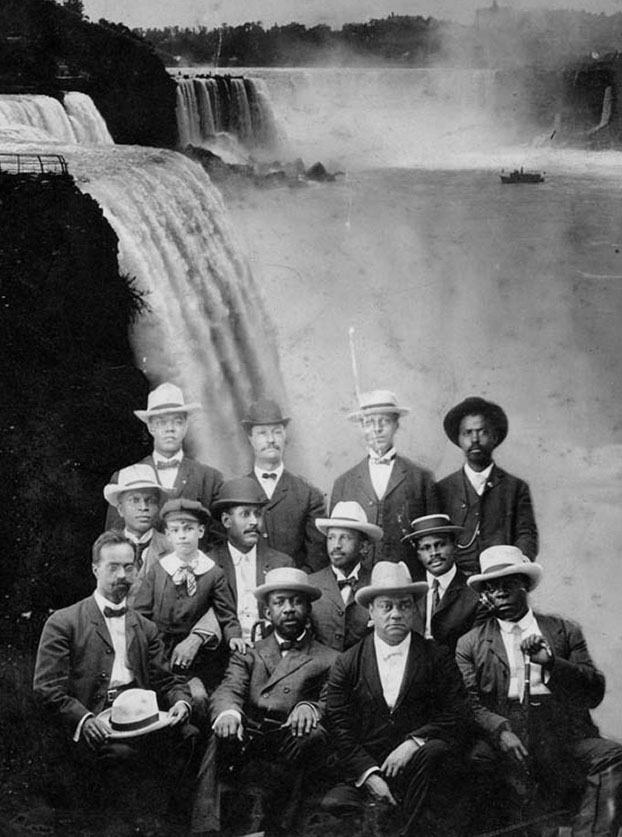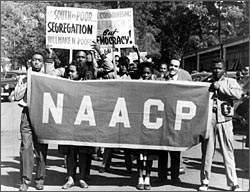
Topics on the Page
The Niagara Movement
W.E.B. Du Bois
The NAACP
Women and the NAACP
Moorfield Story and Guinn v. United States (1915)
 United States History and Black History Cross-Links
United States History and Black History Cross-Links
 Link here for more material on the Niagara Movement and the NAACP
Link here for more material on the Niagara Movement and the NAACP
|
PAGE SUMMARY
The Niagara Movement was a black civil rights organization founded in 1905 by a group of activists, led by W. E. B. Du Bois and William Monroe Trotter. The Niagara Movement forcefully demanded equal economic and educational opportunity as well as the vote for black men and women.
The NAACP (National Association for the Advancement of Colored People), the nation's largest and most widely recognized civil rights organization, was born in 1909. Its mission is to ensure the political, educational, equality of minority group citizens of States and to eliminate race prejudice. The NAACP works to remove all barriers to racial discrimination through democratic processes. (Gabryela Carvalho, April 2022) |
The Niagara Movement
The Niagara Movement was a Black Civil Rights organization, founded in 1905 by W.E.B Du Bois and William M. Trotter.
- It is called the "Niagara Movement" is because it was founded near Niagara Falls on the Canadian side.
-
In 1905, W.E.B Du Bois met with other supporters to discuss demands and principles to end racial segregation disenfranchisement towards African Americans. In other words, he fought for social and political change for this marginalized group.
-
The group originally planned to meet on the American side of Niagara Falls. There was no American hotel that would accept the group. And as a result, that is why the group met on the Canadian side of Niagara Falls.
-
Some of the demands on their list included an end to segregation and discrimination in unions, the courts, and public accommodations. On top of that, the Niagara Movement wanted equal economic and educational opportunities as well.
One of the more important impacts of the Niagara Movement is the formation of the NAACP.
The Niagara Movement, although very popular among like- minded whites, had little impact on legislative or the general population's opinion.
After race riots in Springfield, Illinois in 1909, Jane Addams, John Dewey, William Dean Howells, and Oswald Garrison Villard (a grandson of abolitionist William Lloyd Garrison) formed the National Association for the Advancement of Colored People, more commonly known as the NAACP.
 The Niagara Movement's Declaration of Principles (1905)
The Niagara Movement's Declaration of Principles (1905)
 W.E.B. DuBois
W.E.B. DuBois
Short YouTube biography video on DuBois: https://www.youtube.com/watch?v=TGOEED_MexI
Biography on DuBois: https://www.naacp.org/naacp-history-w-e-b-dubois/
For teachers:
UMass Amherst's Special Collections and University Archives (SCUA) has collected all of W.E.B. DuBois' writings from throughout his life. Digitized into a website called Credo, all of his typed and handwritten speeches and notes are documented online. Use this link for primary source analysis. The collection holds over 100 boxes worth of material, including his correspondence with his children and grandchildren.
For the legacy of the Niagara Movement, SCUA also has a collection dedicated to his only granddaughter, Yolande Du Bois Williams. While this collection isn't digitized, there are papers from an anniversary meeting of the Niagara Movement in which Yolande attended.
If you would like to contact SCUA for more information about this collection, please email scua@umass.edu. All of the W.E.B. Du Bois collection is digitized, so you will not be miss on any documents.
SCUA's W.E.B. Du Bois Collection: SCUA Credo
Short YouTube documentary on the Niagara Movement: https://www.youtube.com/watch?v=bce_CUB6Tls
 Click here for learning modules on the Niagara Movement
Click here for learning modules on the Niagara Movement
The NAACP
- The NAACP is a short-hand for the full name: the National Association for the Advancement of Colored People

- The NAACP was founded during the presidency of Theodore Roosevelt who is the 26th President of the United States, and is one of the largest and oldest civil rights organization in America.
- The NAACP is an organization established in 1909 by a bi-racial group of men and women. This organization was formed due to ongoing violence, like the 1908 Springfield, Illinois race riot. During this event, two Black men held in Springfield jail for alleged crimes against white Americans were transferred to another city jail. A white mob ended up burning down 40 homes and ransacked local businesses in Springfield's Black residential district. Two African Americans were murdered as well.
- Thus, the NAACP was founded on the belief that non-violent protests and legal actions were the most effective ways to secure the equal rights for all Americans.
- The NAACP challenged the "Grandfather Clause", which enabled illiterate whites only to be exempt from a literacy test required to vote. In 1915, the NAACP won a Supreme Court case in Guinn v. United States, which ruled that the "Grandfather Clause was unconstitutional in Oklahoma.
- In 1915, the NAACP protested a pro- Ku Klux Klan movie, The Birth of a Nation. Even though they were unsuccessful in this campaign, it helped the NAACP raise its public profile.
- In 1917, the NAACP hosted a silent march to protest lynchings and other violence against Blacks. As many as 10,000 people in NYC participated. It is important to know that anti- lynching campaigns were one of the NAACP's central focus during its early decades. Even though this group was unsuccessful in getting a federal anti- lynching law passed, their efforts increased public awareness of the issue. Many say their efforts led to an eventual decline in lynchings.
- By 1919, the NAACP had some 90,000 members and more than 300 branches.
- The NAACP played an important role during the Civil Rights Era as well:
 One of their victories was the 1954 Supreme Court case Brown v. Board of Education. This Supreme Court ruling outlawed segregation in public schools.
One of their victories was the 1954 Supreme Court case Brown v. Board of Education. This Supreme Court ruling outlawed segregation in public schools.
Pioneering civil-rights attorney and future Supreme Court Justice Thurgood Marshall, the head of the NAACP Legal Defense and Educational Fund (LDF), successfully argued the case before the court. 
- The NAACP also helped organize the 1963 March on Washington. This march was one of the biggest civil rights rallies in United States history. This march also had a hand in running the 1964 Mississippi Freedom Summer, which was an initiative to register Black Mississippians to vote.
- The NAACP was also successful in supporting the passage of the Civil Rights Act of 1964. This Act prohibited discrimination based on race, color, religion, sex or national origin.
- Also, the Voting Rights Act of 1965 was also successfully passed under the NAACP, which barred racial discrimination in voting. The organization received some criticism for its strategy of working through the judicial system and lawmakers to achieve its goals, rather than focusing on more direct methods of protest favored by other national civil rights groups.
 Many women played a role in the NAACP:
Many women played a role in the NAACP:
- Click here to read about the women who played prominent roles in developing the NAACP

Ida B. Wells, Activist and Journalist
- Anne Moody was a Mississippi native who joined the NAACP in the post-Civil War era, along with other pro-rights organizations. She detailed her experiences in her memoir, Coming of Age in Mississippi.
 Moorfield Storey
Moorfield Storey
A prominent white lawyer from Boston, Massachusetts was one of the first founders of the NAACP ( 1909-1915)
- Born in 1845 in Roxbury MA., Moorfield Storey was the president of the American Bar Association in 1896 and a representative of the Anti-Imperialist League (1905-1921).
- He is famously known for being an advocate in gaining independence for the Philippine Islands, during the 1898 Spanish-American War.
Over the years, the NAACP persuaded presidents to end racial discrimination in the hiring of workers and in terms of military service. From the original sixty founding members, the organization grew to its over 500,000 current members. Presently, the NAACP headquarters is in Baltimore, Maryland.
Booker T. Washington
Pushed by the combined power of Booker T. Washington’s organizations and DuBois’ Niagara Movement, the NAACP created a middle road of interracial cooperation. However, since the end of the Civil Rights Movement, the power of the NAACP has been waning and it has been suffering a decreasing number of memberships and a series of internal scandals.
 Guinn v United States (1915)
Guinn v United States (1915)
- Moorfield Storey argued this case before the Supreme Court
- Guinn v. United States struck down the "grandfather clause" in Oklahoma's Voter Registration Act of 1910 because the clause discriminated against blacks and, therefore, violated the Fifteenth Amendment.
- The statute required voters to pass a reading test. However, the law exempted all those who were entitled to vote on January 1, 1866, just after the Civil War ended (and before the approval in 1870 of the Fifteenth Amendment, which guaranteed voting rights for all male citizens, regardless of race), as well as their descendants.
- The law allowed those whose "grandfathers" were entitled to vote in 1866 to register without passing a literacy test.
 Learning Resources
Learning Resources
NAACP History and Geography, 1909-1980, Mapping Social Movements, University of Washington
Click here for a NAACP timeline from 1905-2008
NAACP's Anti-Lynching Campaign in the 1930s, EDSITEment
Civil Rights Movement Lesson Plans, Wisconsin Historical Society
President Obama Addresses the NAACP, July 20, 2009
The Niagara Movement

Comments (0)
You don't have permission to comment on this page.